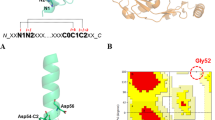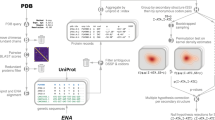Abstract
The equilibrium stabilities of a complete set of single alanine-substitution mutants of the Arc repressor of bacteriophage P22 have been determined by thermal and urea denaturation experiments. Only half the alanine substitutions cause significant changes in stability, with the most deleterious mutations affecting side chains in the hydrophobic core or in salt bridges and hydrogen bonds which are protected from solvent. The five mutations that are most destabilizing affect a cluster of core residues that seem to form a structural foundation for Arc.
This is a preview of subscription content, access via your institution
Access options
Subscribe to this journal
Receive 12 print issues and online access
$189.00 per year
only $15.75 per issue
Buy this article
- Purchase on Springer Link
- Instant access to full article PDF
Prices may be subject to local taxes which are calculated during checkout
Similar content being viewed by others
References
Goldenberg, D.P. Genetic studies of protein stability andmechanisms of folding. A. Rev. Biophys. biophys. Chem. 17, 481–507 (1988)
Alber, T. Mutational effects on protein stability. A. Rev. Biochem. 58, 765–798 (1989)
Dill, K.A. & Shortle D. Denatured states of proteins. A. Rev. Biochem. 60, 795–825 (1991)
Matthews, B.W. Structural and genetic analysis of protein stability. A. Rev. Biochem. 62, 139–160 (1993)
Shortle, D. Denatured states of proteins and their roles in folding and stability. Curr. Opin. struct Biol. 3, 66–74 (1993)
Fersht, A.R. & Serrano, L. Principles of protein stability derived from protein engineering experiments. Curr. Opin. struct. Biol. 3, 75–83 (1993)
Susskind, M.M. & Youderian, P. Bacteriophage P22 antirepressor and its control. in Lambda II. (eds. Hendrix, R.W., Roberts, J.W., Stahl, F.W., & Weisberg, R.A.) 347–364 (Cold Spring Harbor Laboratory, New York, 1983).
Knight, K.L., Bowie, J.U., Vershon, A.K., Kelley, R.D. & Sauer, R.T. The Arc and Mnt repressors: a new class of sequence specific DNA-binding protein. J. biol. Chem. 264, 3639–3642 (1989)
Vershon, A.K., Bowie, J.U., Karplus, T.M., & Sauer, R.T. Isolation and analysis of Arc repressor mutants: evidence for an unusual mechanism of DNA binding. Proteins 1, 302–311 (1986)
Bowie, J.U. & Sauer, R.T. Identifying determinants of folding and activity for a protein of unknown structure. Proc. natn. Acad. Sci. U.S.A. 86, 2152–2156 (1989)
Bowie, J.U. & Sauer, R.T. Equilibrium dissociation and unfolding of the Arc repressor dimer. Biochemistry 28, 7139–7143 (1989)
Milla, M.E. & Sauer, R.T. P22 Arc repressor: folding kinetics of a single domain, dimeric protein. Biochemistry 33, 1125–1133 (1994)
Breg, J.N., van Opheusden, J.H.J., Burgering, M.J., Boelens, R., & Kaptein, R. Structure of Arc repressor in solution: evidence for a family of β -sheet DNA-binding proteins. Nature 346, 586–589 (1990)
Bonvin, A.M., Vis, H., Breg, J.N., Burgering, M.J., Boelens, R. & Kaptein, R. Nuclear magnetic resonance solution structure of the Arc repressor using relaxation matrix calculations. J. molec. Biol. 236 328–341 (1994)
Raumann, B.E., Rould, M.A., Pabo, C.O. & Sauer, R.T. DNA Recognition by β-sheets in the Arc repressor-operator crystal structure. Nature 367, 754–757 (1994)
Milla, M.E., Brown, B.M. & Sauer, R.T. P22 Arc repressor: enhanced expression of unstable mutants by addition of polar C-terminal sequences. Prot. Sci. 2, 2198–2205 (1993)
Becktel, W.J. & Schellman, J.A. Protein stability curves. Biopolymers 26, 1859–1877 (1987)
Serrano, L., Kellis, J.T., Cann, P., Matouschek, A. & Fersht, A. The folding of an enzyme II. Substructure of barnase and the contribution of different interactions to protein stability. J. molec. Biol. 224, 783–804 (1992)
Brown, B.M., Milla, M.E., Smith, T.L. & Sauer, R.T. Scanning mutagenesis of Arc repressor as a functional probe of operator recognition. Nature struct. Biol. 1, 164–168 (1994)
Rosenberg, A.H., Lade, B.N., Chui, D.-s., Lin, S.-W., Dunn, J.J. & Studier, F.W. Vectors for selective expression of cloned DNAs by T7 RNA polymerase. Gene 56, 125–135 (1987)
Studier, F.W. & Moffatt, B.A. Use of bacteriophage T7 RNA polymerase to direct selective high-level expression of cloned genes. J. molec. Biol. 189, 113–130 (1986)
Brown, B.M., Bowie, J.U. & Sauer, R.T. Arc repressor is tetrameric when bound to operator DNA. Biochemistry 29, 11189–11195 (1990)
Author information
Authors and Affiliations
Rights and permissions
About this article
Cite this article
Milla, M., Brown, B. & Sauer, R. Protein stability effects of a complete set of alanine substitutions in Arc repressor. Nat Struct Mol Biol 1, 518–523 (1994). https://doi.org/10.1038/nsb0894-518
Received:
Accepted:
Issue Date:
DOI: https://doi.org/10.1038/nsb0894-518
This article is cited by
-
Missense meanderings in sequence space: a biophysical view of protein evolution
Nature Reviews Genetics (2005)
-
Important role of hydrogen bonds in the structurally polarized transition state for folding of the src SH3 domain
Nature Structural & Molecular Biology (1998)
-
Are buried salt bridges important for protein stability and conformational specificity?
Nature Structural & Molecular Biology (1995)
-
Can proteins be turned inside-out?
Nature Structural & Molecular Biology (1995)



